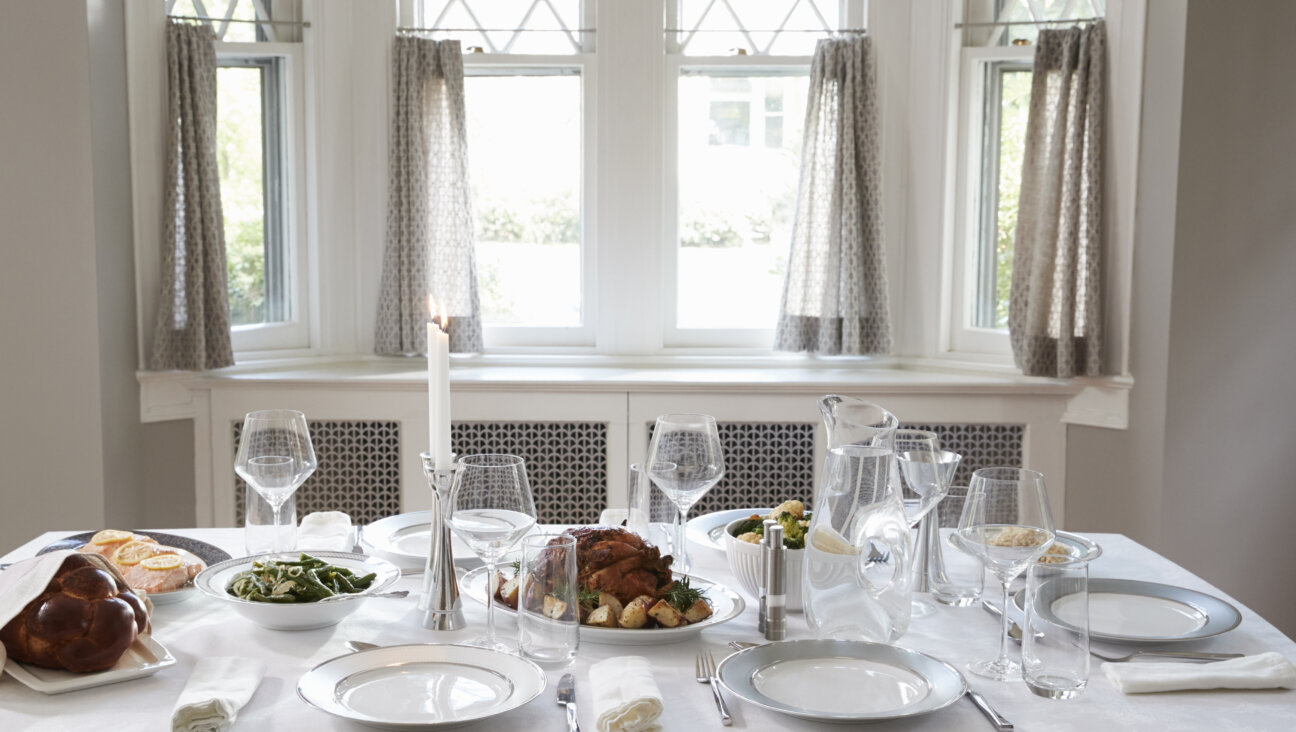Beyond Blintzes: A Culinary Tour of Shavuot

Graphic by Angelie Zaslavsky
Cheesecake and blintzes hold an important place in the realm of Jewish cuisine, but they aren’t the be all and end all of Shavuot foods. In fact, there are many unique dishes — both dairy and nondairy — associated with the holiday that reflect the culinary traditions of Jews around the world.
The many names for Shavuot offer insight to the holiday’s foods. As the Feast of First Fruits, it marks the earliest availability of the fruit harvest. Thus, cold fruit soups start many Hungarian and Czech Shavuot meals. Sour cherry soup, with or without the addition of red wine, is popular in Israel, thanks to German Jewish immigrants who adapted the custom from their summer fare on the Baltic Sea. Variations include raspberry, strawberry and rhubarb, or sorrel (a leafy green with a lemony flavor), the latter used in the Russian soup schav. All these ingredients are late spring crops.
Such a dish might be accompanied by one of the many symbolic loaves of bread prepared on Shavuot, like the ladder-shaped challah popular with Jews from Ukraine. The design represents Moses’ ascent up Mount Sinai, with a nod to the similar numerical value for the Hebrew words for “ladder” and “Sinai.” There are often seven rungs for the seven spheres through which God is said to have descended to reach Moses, and for the end of the seven weeks of the Counting of the Omer.
For the same reasons, Jews of Tunisia and Morocco make a seven-layer cake known as siete cielos. Other thematically appropriate baked goods include loaves shaped like the two tablets and extra-long loaves for the long reach of the Laws of the Torah.
While Jewish breads are typically dairy-free, making them compatible with any kosher meal, Shavuot recipes pump pastries with milk, butter, yogurt and, of course, cheese. For instance, levivot, a type of pancake eaten in Israel on both Shavuot and Hanukkah, contains little else but cottage cheese.
The most thoroughly symbolic Shavuot dish just might be soutlach, a Turkish rice pudding that includes four meaningful ingredients: milk, honey, rose water and, naturally, rice. The milk and honey hail from the infamous Song of Songs reference; the rose water is attributed to the custom, in some Sephardic communities, of celebrating Shavuot as the Feast of Roses, and the whiteness of the rice is likened to the purity of the Torah. Serving rice on the holiday is also reflective of the belief that Shavuot is a wedding between God and the Jews, as rice is a customary food at weddings.
The following recipes are creative additions to Shavuot celebrations.
Cheese Levivot — Pancakes
Yield: About 20 Pancakes
Adapted from Joan Nathan’s “The Foods of Israel Today” (Alfred A. Knopf, 2001)
2 large eggs
2 cups cottage cheese
½ cup all-purpose flour
½ teaspoon baking powder
1 teaspoon salt 1 teaspoon plus 2 tablespoons sugar (Note: optional)
2 tablespoons unsalted butter
2 tablespoons vegetable oil
½ teaspoon cinnamon (Note: optional)
-
Beat the eggs with a whisk until fluffy. Add the cheese, flour, baking powder and salt, and 1 teaspoon of the sugar, and mix well.
-
Heat a griddle or a nonstick skillet; add 1 tablespoon of the butter and 1 tablespoon of the vegetable oil, and heat until the butter is melted. Pour a heaping tablespoon of batter onto the skillet, flattening slightly with the back of the spoon. Cook in batches until golden brown, turn and brown on other side. Repeat with the remaining batter, using the rest of the butter and oil when needed. Drain the pancakes on paper towels.
-
Mix the remaining sugar and the cinnamon in a small bowl. Serve the pancakes sprinkled with the cinnamon and sugar.
Cold Sour Cherry Soup
Serves 6-8
From Joan Nathan’s “Jewish Holiday Cookbook” (Schocken Books)
Two 20-ounce cans or 2 pounds fresh pitted sour cherries
1 cup sugar, or to taste
1 cinnamon stick
1 cup sour cream, plus additional for garnish
1 cup dry red wine (optional)
-
Drain the canned cherries and pour the juice in a saucepan. Set the cherries aside. Add enough water to the juice to make 3 cups. If using fresh cherries, add 3 cups water. Add the sugar and the cinnamon stick. Bring to a boil, stirring to dissolve the sugar, and add the cherries. Partially cover and simmer over low heat for 10-15 minutes.
-
Remove the cinnamon stick. Remove a few cherries (and return them later for texture) and blend the rest in a food processor equipped with a steel blade until smooth.
-
Bring the soup back to a boil. Let it cool a bit and then whisk in the sour cream, letting it dissolve. Add the reserved cherries and chill.
-
Before serving, add the wine, if using. Garnish each bowl with a dollop of sour cream or pass the sour cream at the table.
Boyikos de Keso, or Peppery Cheese Biscuits
Makes about 20 biscuits
Adapted from Joyce Goldstein’s “Sephardic Flavors: Jewish Cooking of the Mediterranean” (Chronicle Books, 2000)
2 ½ cups all-purpose flour, or as needed
2 1⁄4 teaspoons salt
½ to ¾ teaspoon red pepper flakes
1 cup grated Kasseri or other full-flavored cheese, plus more for sprinkling on the tops (optional)
¾ cup sunflower or canola oil
¼ cup water
1 egg yolk, lightly beaten
¼ cup snipped chives
-
Preheat the oven to 350 degrees Fahrenheit. Line a baking sheet with parchment paper or lightly oil.
-
In a bowl, stir together the flour, salt, red pepper flakes, chives and 1 cup cheese. Add the oil and water and stir until the dough comes together. Alternatively, combine the flour, salt, red pepper flakes and 1 cup cheese in a food processor and pulse to combine. Add the oil and water and process until the dough comes together.
-
Shape the dough into a ball and place on a floured work surface. Flatten the dough and roll out or pat out into a round ¼ inch think. Using a 2-inch biscuit cutter, cut out rounds. Place the rounds on the prepared baking sheets about ½ inch apart. They do not spread. Gather up the scraps, roll out or pat out again, and cut out more rounds. Brush the tops with the egg yolk and, if desired, sprinkle them lightly with grated cheese.
-
Bake the biscuits until golden, about 25 minutes. Remove from the oven and serve warm. They also can be allowed to cool on a rack, stored in an airtight container for several days, and then reheated in a low oven.
Mark Talisman’s Bagels
Makes 20-24
Adapted from Joan Nathan’s “Jewish Holiday Cookbook” (Schocken Books)
2 tablespoons butter
1 cup milk, scalded
2 scant tablespoons (2 packages) active dry yeast
Pinch of sugar (for yeast)
2 cups warm water
8 cups unbleached all-purpose flour (approximately)
1 tablespoon salt
3 quarts water>2 tablespoons kosher salt>Sesame, poppy or caraway seeds>1 cup chopped scallions
-
Melt the butter in the scalded milk.
-
Dissolve the yeast with a pinch of sugar in the warm water.
-
After allowing the milk to cool somewhat so that it doesn’t kill the yeast, combine the two liquid mixtures in a large bowl and gradually blend in the flour and the salt and scallions until a soft, sticky dough is formed. (A food processor is fine to start this.) Knead well and place in a bowl greased with the olive oil. Cover and let rise in a warm place until doubled in size, about 1 hour.
-
Preheat the oven to 400 degrees Fahrenheit. Boil the 3 quarts water with the kosher salt.
-
Knead the dough again on a floured board. Break off a piece about the size of a plum and roll out into a 5 1/2-inch-long snakelike shape, tapering the dough at each end. Twist into a circle and press the ends together. Place on a floured board. Continue until all the dough is used up. Let stand, uncovered, until the dough begins to rise, about 10 minutes. If at this point your hole has closed due to rising, feel free to poke a new one.
-
Drop the bagels one by one into the boiling salted water, boiling a few at a time. Cover and wait until the water boils again. With a slotted spoon, turn the bagels, cover again and wait until the water boils, about 2 minutes. (The water gives the bagels a crunchy crust.) Remove to a greased cookie sheet.
-
Sprinkle with sesame, poppy or caraway seeds and more salt and bake about 30 minutes, or until golden. These bagels freeze well.
Note: These will not be as hard as commercial bagels, because no preservatives are used. They are deliciously crunchy on the outside and chewy inside.














